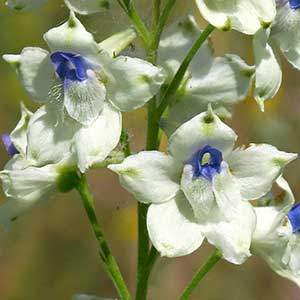Delphinium nuttallii subsp. ochroleucum
(synonym of Delphinium leucophaeum)
Delphinium bicolor
pale larkspur, white rock larkspur
Flathead larkspur, little larkspur, low larkspur, Montana larkspur
30-60 cm.
10-40(-70) cm;
base often reddish, glabrous to puberulent.
blade round, 1-4 × 1.5-7 cm, glabrous to puberulent; ultimate lobes 3-19, width 1-8 mm (basal), 1-3 mm (cauline).
3-12(-22)-flowered;
pedicel 1-4(-8) cm, ± puberulent;
bracteoles 2-7(-17) mm from flowers, green, sometimes white-margined, lanceolate, 4-6(-8) mm, puberulent.
sepals white or light yellow, spurs 9-11 mm;
lower petal blades 4-6 mm.
sepals dark blue, puberulent, lateral sepals usually spreading, 16-21 × 6-12 mm, spurs straight to gently decurved, ascending 0-40° above horizontal, 13-23 mm;
lower petal blades covering stamens, 7-12 mm, clefts 0.1-3 mm;
hairs sparse, short, mostly on inner lobes below junction of blade and claw, white or yellow.
(12-)16-22 mm, 4-4.5 times longer than wide, usually puberulent.
often winged;
seed coat cells with surfaces ± smooth.
= 16.
Delphinium nuttallii subsp. ochroleucum
Delphinium bicolor
Of conservation concern.
The range of morphologic features of Delphinium nuttallii subsp. ochroleucum (D. leucophaeum) is almost completely encompassed within that of D. nuttallii subsp. nuttallii. Sepal color is the only feature consistently separating the two subspecies. Were it not for the fact that any given population typically has plants of only one flower color, a rank of forma would be more appropriate.
(Discussion copyrighted by Flora of North America; reprinted with permission.)
Subspecies 2 (2 in the flora).
Delphinium bicolor is closely related to D. glareosum; it differs in its wider-lobed cauline leaves, shallower petal clefts, and narrower fruits.
The Gosiute consider this plant to be poisonous (D. E. Moerman 1986, subspecies not specified).
(Discussion copyrighted by Flora of North America; reprinted with permission.)
1. Sepals (especially in fresh material) dark blue to purple; cleft in lower petals 2 mm or less; soils not derived from limestone. | subsp. bicolor |
1. Sepals (especially in fresh material) bright dark blue; cleft in lower petals at least 2 mm; soils derived from limestone. | subsp. calcicola |


